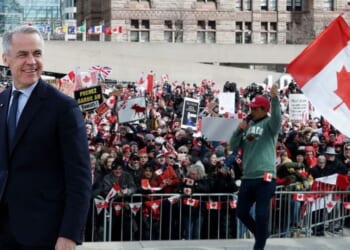President Donald Trump met with Federal Reserve Chairman Jerome Powell this week, striking a lighter tone between himself and the Fed following a tour of the central bank’s headquarters. But the Fed holding interest rates steady once again next week could be a blow to that truce.
Trump has harangued Powell nonstop for weeks for not lowering interest rates, and the administration has questioned Powell’s stewardship over the central bank because of price overruns that are part of the Fed’s multiyear renovation. But Trump left the Thursday meeting with the impression that Powell could soon be pushing for cuts.
On Friday, Trump reiterated his belief that Powell will urge the Fed’s monetary policy committee to lower interest rates.
Powell “said to me very strongly, ‘The country is doing well.’ He said, ‘Congratulations, the country is doing really well,’” Trump told reporters at the White House. “And I got that to mean that I think he’s going to start recommending lower rates.”
The Fed will announce its interest rate decision next Wednesday, and while Trump seems to expect a rate cut, the market thinks there is almost no chance of it.
Investors indicate only a 2.6% chance that rates will be cut, according to the CME Group’s FedWatch tool, which calculates the probability using futures contract prices for rates in the short-term market targeted by the Fed.
A decision not to cut rates would likely embolden Trump, who is pushing for massively lower rates, against the Fed’s current course of monetary policy.
“I think if Trump was saying nice things, I think it’s because he was in a good mood — I would expect more fire and brimstone next week,” Ryan Young, a senior economist at the Competitive Enterprise Institute, told the Washington Examiner.
During Trump’s tour of the Fed, which came as his allies have painted Powell as mismanaging the Fed’s planned renovation and running well over budget, Trump railed against the higher interest rates, but struck a less combative tone toward Powell and indicated that he won’t be firing Powell or pushing him to resign.
The president also indicated that he didn’t think the cost overruns on the building renovation constituted a fireable offense.
“There’s always Monday morning quarterbacks, I don’t want to be that,” Trump said. “I want to help them get it finished. It’s been going around for years, and I want to help them get it finished.”
But while the Fed renovations were the topic du jour as part of the headquarters tour, the real elephant in the room was interest rates and the Fed’s refusal to cut them.
Mark Hamrick, senior economic analyst at Bankrate, said the central bank is not expected to slash rates at its meeting next week but might do so later this summer.
“It would be quite surprising if the Fed cut interest rates at its July meeting, and there’s seemingly a possibility that the next rate cut could come in September,” Hamrick told the Washington Examiner.
There is a 64% chance that the Fed will finally cut interest rates in September, according to CME.
But even if there were a cut in September, it would likely be small, bringing the federal funds rate down to 4% to 4.25%. That is well above what Trump has been pushing for. He has said he would like to see rates at an ultra-low 1%.
Complicating matters are the myriad economic data that the Fed is trying to interpret.
The central bank has a dual mandate: price stability and maximum employment. Interest rates are the main tool in its arsenal. Typically, it lowers rates to bring inflation down. When the economy appears to be slowing, it cuts rates to boost overall spending.
Inflation is still floating above the Fed’s 2% goal, and some fear that any move to slash interest rates could cause inflation to tick back up.
Recently, the closely watched consumer price index rose by three-tenths of a percentage point to 2.7% for the year ending in June.
Another big question is how the economy will absorb Trump’s tariffs.
“Chief among the questions … is whether there’s going to be some further inflation related to tariffs given the fact that the president seems quite intent on utilizing tariffs as essentially a fundamental part of his administration,” Hamrick said.
Also, a key report on economic growth is set to come out next week, just hours before the Fed makes its next decision on interest rates.
Economic growth earlier in the year raised concerns. Gross domestic product contracted at an annual rate of 0.5% in the first quarter, which would typically lend credence to the notion that the Fed might cut rates sooner.
But since then, GDP growth has likely expanded in the second quarter, and the first official report on the matter will be released on Wednesday morning. The Atlanta Fed’s “GDPNow” tracker predicts GDP growth in the second quarter will be a strong 2.4%, according to the latest estimate.
If the reading is stronger than expected, it might also give the Fed more wiggle room to keep rates high.
“Because if the economy’s already growing, there’s no need to cut rates,” Young said.
TRUMP TOURS FED CONSTRUCTION WITH POWELL IN AWKWARD ENCOUNTER
But regardless of what might happen with interest rates next week, it is unlikely that the Trump administration’s attacks against Powell and the Fed will go away anytime soon.
“Powell has disagreed with the president in the past, the president’s attacked him,” Peter Loge, director of the George Washington University School of Media and Public Affairs, told the Washington Examiner. “He’s creating an opening now for Powell to agree with him. When Powell does not lower rates, Trump will then attack him.”















